The scanner can display an image on a TV. The HDMI-out works for LED TVs while Component AV-out is for CRT models. Both cables are included in the set.
The slide holders are a bit tricky to use.
Produced by the leader in the industry, the Kodak Scanza Digital Film Scanner boasts the highest quality and functionality. It offers the easy way to eternalise memorable moments of your life captured on slides and negatives.
14 Megapixels (Interpolation to 22 Megapixels)
3.5" TFT LCD screen
Converts 35mm, 126KPK, 110 and Super 8 and 8mm film negatives and slides into digital images
Few seconds
PC/Mac compatible (no software required), Video-out for TV connection (Component and HDMI cables included), Brightness and colour adjustment, slot for microSD card
1 year
It's designed with a large, high-contrast 4.3" LCD screen which makes it easier to scan slides and allows you to view the result even without the need to connect the device to the computer.
The buttons are rather plasticky.
The Rybozen 22MP Scanner is very straightforward to use. It comes with a comprehensive manual and is fitted with large responsive buttons and a well-readable display. Compatible with all Windows/Mac OS computers.
14 Megapixels (Interpolation to 22 Megapixels)
4.3" TFT LCD screen
Converts 35mm, 126KPK, 110 and Super 8 and 8mm film negatives and slides into digital images
Few seconds
PC/Mac compatible (no software required), Video-out for TV connection (HDMI cable not included), Slot for SD card
1 year
The Continuous Loading feature along with Rapid slide feeder allows you to scan a great number of slides, spending minimum time and effort. The SD card slot supports media up to 32 GB (sold separately).
The colours could be more vivid.
If you've got tons of slides and films to scan, the DIGITNOW!High Resolution 135 Film/Slide Scanner may be up to the task. Not only is it very quick to operate, but it also provides images of decent quality.
5 Megapixels (Interpolation to 10 Megapixels)
2.4" TFT LCD screen
Converts 35mm slides and 135/110/126 negatives into digital images
Few seconds
PC/Mac compatible (no software required), Video-out for TV connection (Component cable included), Slot for SD card
1 year
The integrated auto-exposure and auto-colour balance features will help you obtain images of the highest quality.
The tiniest details on the photos might be lost sometimes.
Easy to master and use, the Veho VFS-014-SF scanner for digitising slides and films can work with or without PC connection and provides quality images of up to 2MB.
14 Megapixels
2.4" TFT LCD screen
Converts 35mm slides and 135/110/126 negatives into digital images
Few seconds
PC/Mac compatible (no software required), Video-out for TV connection (Component cable included), Colour balance and other image enhancements, Slot for SD card
1 year
The box includes a cleaning brush that will come in handy if you've got old, dusty slides. The device is powered via a USB port, so there is no need to plug it into a socket.
It has no screen.
Those who're on a tight budget may like the Rybozen USB 35mm Film Scanner. Although it doesn't provide as clear digitalised images as its higher-end counterparts, it works quite well for the price.
2 Megapixels
No screen
Convert 35mm slides and 135/110/126 negatives into digital images
Few seconds
PC/Mac compatible (software required)
1 year
This site is a free online resource that strives to offer helpful content and comparison features to its visitors. Please be advised that the operator of this site accepts advertising compensation from certain companies that appear on the site, and such compensation impacts the location and order in which the companies (and/or their products) are presented, and in some cases may also impact the scoring that is assigned to them. The scoring that appears on this site is determined by the site operator in its sole discretion, and should NOT be relied upon for accuracy purposes. In fact, Company/product listings on this page DO NOT imply endorsement by the site operator. Except as expressly set forth in our Terms of Use, all representations and warranties regarding the information presented on this page are disclaimed. The information which appears on this site is subject to change at any time. More info
Kodak SCANZA
Authentic Kodak Experience
Offered by the leader in the industry, the Kodak Scanza is an ideal little film scanner for those who'd like to effortlessly make digital copies of older slides and films. With it, you'll be able to scan a wide variety of films including 35mm, 126, 110, as well as Super 8 and 8mm negatives, and then optimise, share and print them.
First things first, we would like to note that the Scanza captures images using a built-in mini digital camera with 14 MP resolution and f/2.8 aperture. That's why images captured by the Scanza are definitely good enough for displaying on an HD monitor. That is to say, the Scanza is able to create 2880 dpi x 4320 dpi images from 35mm slides and then upscale them to 22 megapixels (via integrated interpolation) for better image quality.
For easy editing, the Scanza interface offers straightforward navigation split into three modes - Gallery (view, flip, rotate and delete photos), Capture (scanning, saving and adjusting brightness and RGB) and Settings (resolution and LCD brightness adjustment, uploading to computer and more).

So Easy to Use
Users will definitely appreciate the fact that the Kodak Scanza comes with everything you may need to start scanning. The box even includes the bonus video and HDMI cables allowing you to project your memories on a TV screen or other compatible equipment straight away, without the need to purchase anything else. Also, it's supplied with a USB cable to hook it up to your PC.
Besides the cables, the set includes various film adapters and inserts to easily prepare your old films for convenient loading. Just click the inserts with slides into the unit, and press "Start" for speedy scanning. No need for a magazine of 4-5 slides to be mounted and then pushed through the machine.
Bottom line, we can't highly recommend this slider to anyone who looks for a quality piece of equipment that will quickly scan slides onto digital media. It's very easy to use, simple and fast.

Additional Info
| Last updated price | £149.99 |
| Stock | In stock |
| ASIN | B00O2BU8PK |
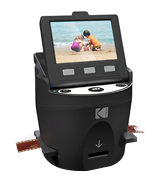
Rybozen 22MP
Fitted with a Large Screen and HDMI Out
Rybozen offers another high-end film scanner that can compete with big names in terms of functionality, ease of use, and clarity. Fitted with a 14 MP sensor, it can take high-quality images and then enhance them up to a whopping 22 megapixels.
To get started, the device comes with comprehensive instructions that can help you wrap your mind around the menus and functions. In general, you simply need to insert a slide or film into the corresponding slot and then press the "scan" button to convert them into digital photos. Do note that some images may require post-processing afterwards (rotating or colour enhancing), but luckily, all the adjustments can be easily done using the large buttons under the 4.3" LCD screen. Similar in size to a slide viewer, the screen will help you conveniently view slideshows and edit images.
Yet, if the large display like this isn't enough for your needs, you can hook the device up to a TV since the scanner is fitted with HDMI out jack to let you view images on TV/Monitor in HD resolution. Having an HDMI out is something other similar units typically don't have, and for sure, this may rid you of need to use an additional projector and screen.

Nice Extras
The Rybozen scanner also connects to a computer via USB, allowing you to read DCM files or do some adjustments. For example, you can remove some scratches, dust marks, and other minor issues using Photoshop or Corel. That being said, the scanner itself is set to the interpolation upscaling by default, so you're likely to be very pleased with the resolution and quality of the images. The machine produces well-saturated colours that can be further corrected using the plus and negative RGB setting scales. You can adjust the exposure and cool/warm tones, as well as correct the images taken under the old fluorescent green cast lighting.
Understanding that the great picture reproduction alone can't deliver high-quality images, the manufacturer has included the cleaning brush in the set. By using this tiny brush, you'll be able to pick up all the dust left behind by negatives and always get as flawless results as possible.
All things considered, the Rybozen Film Scanner is a really useful kit for those who're after superb image quality. It delivers 22MP high-resolution pictures and is very easy to operate owing to the extra-large display.
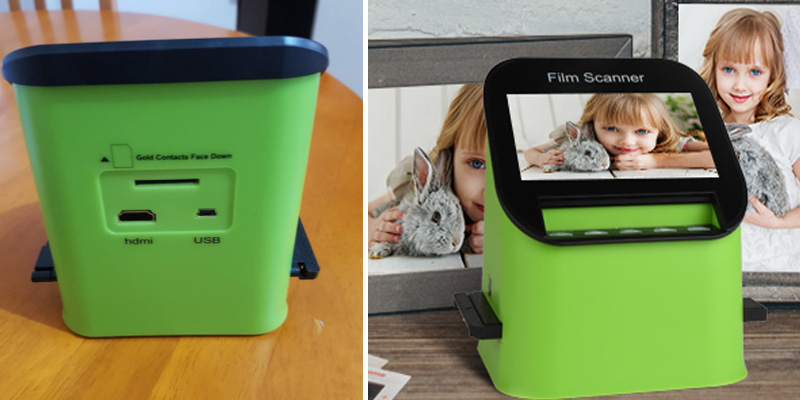
| Last updated price | £99.99 |
| Stock | In stock |
| ASIN | B0858WY6BM |

DIGITNOW! M125
Affordable Option
If you have hundreds of old 35mm sides put away in boxes somewhere in the attic, you probably need a quick and inexpensive device for their duplication, something like the DIGITNOW High-Resolution Film/Slide Scanner. It's a decent middle-ground product that can scan a great number of slides within the shortest time possible. Although it has less fancy options and lower-end software compared to big names, it still has a lot going for it.
To begin with, the device suits standard 35mm slides or negatives and at the touch of a button, it allows you to digitise them as JPG files to the inserted SD card or computer in 1800dpi high resolution. When it captures slides in standard 5MP mode, it delivers images with 2736 x 1824 pixels. But if you choose the "10MP interpolation" mode, you'll get 3888 x 2588 pixels. Then, you can re-size the images and make some other minor adjustments using the controls on the device. Also, it's fitted with a 2.4" TFT LCD screen. Admittedly, this display is a bit smaller compared to the competition but we're surprised to see it within this price range at all.
Take note that the device works fine with plastic slides of standard size, but square slides may not fit properly in the slot, which may result in cropped images. So, if you have non-traditional slides, you may need to check that before buying.

Three Simple Steps
With this film converter, you can digitalise your slides and negatives into sharp, vibrant JPEG images in just three simple steps. At first, you should load your slides into the scanner using the negative or slide holder (included in the set). Next, you plug the device into a wall socket with the included power adapter. And finally, you start scanning your slides and negatives by pressing the “Scan” button. Snap! The images will be saved to the internal memory or an optional SD card, letting you transfer them to your computer or printer, view them on your TV, or print out as regular photos.
Dissimilar to most other scanners, this model is fitted with the rapid slide feeder that can take about 6-8 pieces at a time. Once it starts, the device works quickly and efficiently with no jams. So, if you've got a large number of slides to scan, this image digitiser may be the best bet for you.
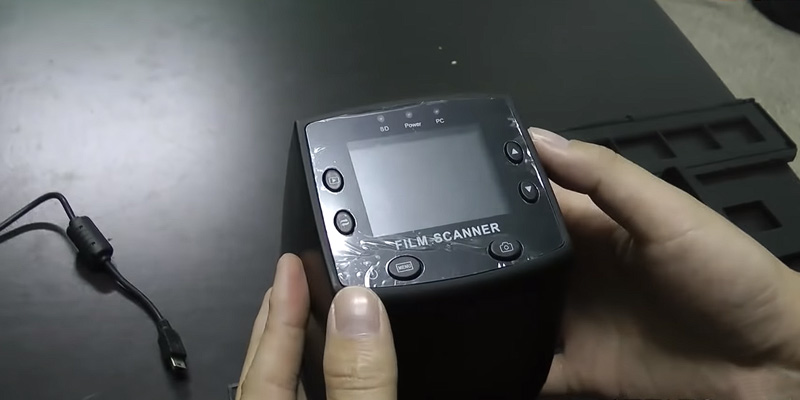
| Last updated price | £54.99 |
| Stock | In stock |
| ASIN | B01HZQZLXW |
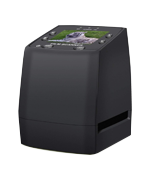
Veho VFS-014-SF
The Tiniest Thing
The Veho Smartfix is one of the lightest slide scanners on the market if not the lightest one, its listed weight is mere 363 grammes. And with the dimensions of 10.9 x 14 x 9.9 cm, you might actually forget you have it in your handbag. Carrying it around is the simplest thing possible, you can gather all the slides and negatives from your friend and family to scan them right there and then, without having to carry them home where there are chances of getting them mixed, for example, or worse—damaged and lost. It is quite pleasant to the touch as well, the housing has a Tacton rubber touch finish.
With the scanning quality at 14 megapixels, a nice 2.4" TFT LCD display, and one-touch scanning functionality with image enhancement features like auto-exposure and colour balance, it is also a handy tool for a journalist working with digital media and aiming to deliver the scoop to the editorial department as quickly as possible: you just pack this tiny slide scanner into your bag you carry around, take the photos you need, scan them, transfer them to your MacBook, attach to the mail, and hit send! In a moment, they are delivered to your boss and posted with a hit story before anyone from the rival magazine catches the wind of what's going on. (We do encourage you to hold onto journalist ethics, though.)
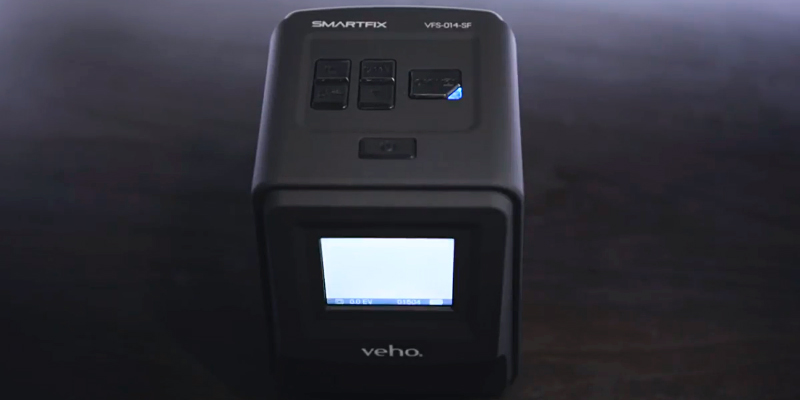
Great Price-to-Quality Ratio
This Veho slide scanner and negative reader will convert 135 slides and 135/110/126 negatives into the digital form for safekeeping of memories and for further enhancement and creativity. It has a quality Lithium-ion battery that can be recharged via either a USB cord or from the mains (with the help of the 3-pin plug with a USB port). The same USB cord can be used to transfer the scanned photos to your laptop or PC if it lacks the SDHC / SD card slot. The card itself is not included with the purchase and the supported card storage space is stated to be up to 32 GB.
The scanning speed is fast, it will take approximately 3 seconds for a single slide to be scanned, though some users suggest you wait for the autofocus to settle before you push the scanning button. It is also possible in some cases for the smallest details to be lost during scanning but when we say "smallest" we do mean it: you might only notice it if you compare these scans to the ones made with a scanner that offers much bigger DPI and, consequently, costs quite a bit more. For the price this model is sold at, we find it very functional.
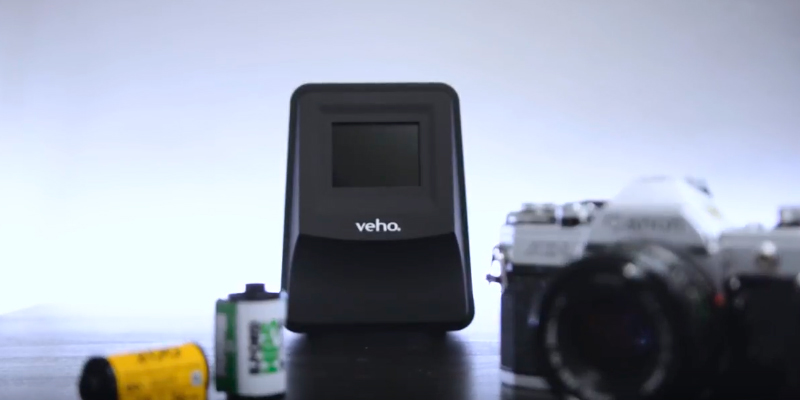
Additional Info
| Last updated price | £79.95 |
| Stock | In stock |
| ASIN | B072KKDL3N |
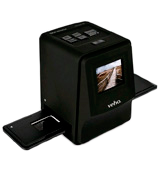
Rybozen USB
Frills-free Model
If you're on a tight budget and need a good machine for converting slides and then transferring them to your PC, you should definitely consider this Rybozen scanner. It's a frills-free model that costs less than £50 but still does a decent job of digitalising your old memories into images.
As just mentioned, it's a barebones device that has no extras like a control panel with a display, and accordingly, it doesn't allow you to view images and make quick adjustments right after scanning. Also, it has no slot for an SD memory card. Instead, it connects right to your PC with the included USB cable that does double duty by powering the device and transferring files to your computer at the same time. This means less mess with additional wires, less money spent on additional SD cards, and total flexibility of use (no need for a power socket).

Authentic Feel
The other thing to note is that the 35mm film must be processed into negatives first and then placed into this device. The software can convert monochrome, colour 35mm and slides into digital format with native 1800 dpi or interpolation 3600 dpi resolution. This format is equivalent to early mobile phone cameras but is quite sufficient for home use - the reproductions come with some "Authentic" film texture.
Lastly, if you've got too old, dusty slides, you'll appreciate the fact that the manufacturer has thoughtfully included the small cleaning brush into the box. It's very gentle on slides but tough on dust and tiny particles. So, if you're after a decent kit that offers quite a lot for the price and delivers good images, this Rybozen scanner may be a go-to option.
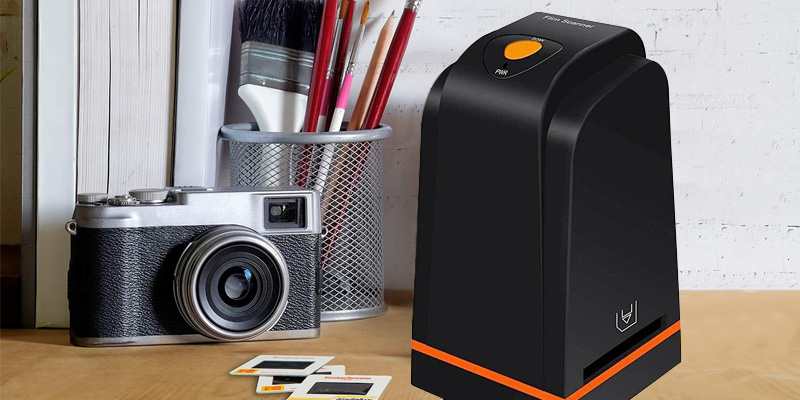
| Last updated price | £39.99 |
| Stock | In stock |
| ASIN | B07GB43Q79 |
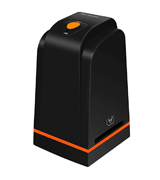
What Is a Slide Scanner?
In the digital age, we can easily snap a picture with our phone and upload it to any web source. But what about the old slides and printed photographs stored away in the attic, collecting dust? Is there a way to bring life in those pictures and share them with other people online? Well, there actually is, and it is a slide scanner, an electronic appliance used to convert all real photos to the digital format to keep on a computer or an SD card. The operation principle is pretty simple. You place a picture in the slot, wait a second until it takes its photo and then it is converted to a digital file. The digitized copies can be stored either on a flash card or written directly on the hard drive. Easy as that.
As a side note, the inkjet printers can provide you with quick copies from the scanned negatives. You can also buy a portable pico projector for showing off your digital photos collection to your friends and relatives.
What Features to Compare
Resolution
Resolution. Simply put, this refers to how huge your digital copy of the film or the photo will appear on the computer screen. As a rule, the bigger it is, the more details will be seen on it. If you are going to further process the image in the graphics editor, you will require at the very least 1800 dpi resolution for 35mm film slides. However, even 5 MP will be enough if you just need to quickly scan a bunch of slides to store them further on your PC. 200-400 dpi will be enough for most programs to effectively recognise the printed text from the scanned slides.
Intended Use
Taking into account the intended use, you will be able to figure out what types of film formats and/or photo sizes exactly the scanner can process for you. Usually, the slide converters have either special slide adaptors or an adjustable tray for this. You need to make sure the chosen slide scanner is compatible with the films you've got at your disposal.
Scanning Speed
Scanning speed is a pretty straightforward characteristic, too. If you are searching for a slide scanner to use in a little print shop, a quick scanning speed will considerably reduce a wait time for consumers in the line.
Additional Features
Additional features may include a variety of things. For instance, some of the scanners come with a small screen for checking a slide position inside the scanner. Others might come together with a cable so that they could be connected to other appliances (TV screens, PC monitors, etc.). A lot of slide scanners offer versatility of use and can work not only with the film but also with photos, just like conventional PC scanners do.
Did you know?
Slides are not negatives
When you read the “in the box” part of your future digital slide scanner, you’ll most likely see that there are different trays for mounted slides and for negatives. Some of us presume, at first, that they only differ because slides are of different size due to the casing. In reality, it is not true: whereas negative film does offer you an image with its colours inverted, the film inside a slide is actually a positive, that is, with the colours the way they will be when you scan the slide.
Film is better for scanning than printed photos
A film, both positive and negative, contains more information about the image than any printed photo can. At least, with the level of printing technology we have today, let alone the technology we used to have before the digital age. Scanning a film, especially with a dedicated slide scanner, will result in an image of richer and deeper colours, with more contrast and luminance and, as a consequence, with more details. Film also allows for better resolution for scanning, which, in its turn, offers bigger images without any quality losses.
Just about anything can damage a negative
One might think that storing a film suspended in the air in a closed dark room where neither kids nor pets ever come is safe. Unfortunately, this is not true. A film is a very fragile material, and it can be damaged not only by accidental nail or paper touch but by a thing as unavoidable as air movement. Yes, it is true, no, we’re not joking here. The problem is, there is no such thing as clean air, not really. Invisible to the naked eye, there is always some dust or tiny debris moved by even the slightest blow of wind. As tender as the film is, it won’t take much time for a scratch or two to appear. And you most probably won’t even see it on the film. Where you will see it is on the scans and prints done years later. That’s why it is recommended to use a scanner for slides and negatives as early as possible to preserve the memories. After that, you can give the film to a professional for cleaning and then store it in an air-tight container.
There is a trend in photography where they damage the negatives on purpose
Lately, it has been a trend in not only photography but in other industries as well. Torn and damaged jeans, muddy prints on t-shirts, even old-looking music videos (have you seen Coldplay’s Up&Up?). This trend hasn’t passed photo industry by: the photos are bleached, burnt, distressed, and scratched on purpose, then put into film and slide scanner. Glen Luchford, a talented photographer, even has published a book called Damaged Negatives in 2012, though hers weren’t destroyed intentionally but rather had fallen victims to an unfortunate accident. So why is this so popular? People just love broken things, don't they?
Your photos are actually cropped to some extent
You can compare your scanned film with the photos printed in the special stores—to fit into a specific mould the size of the photo you have ordered, the image on the negative is usually cropped at the sides a bit. Sometimes, this "bit" can reach up to 10–15% of the picture and be different on each side. It does not always matter much since we always try to leave space around people on the photos so they don't look crowded but there are cases when the details at the edges might be important, and scanning a slide always leaves it up to you to decide what you want to crop.
FAQ:
Q: What format is the best for scanning slides?
A: The format home slide scanners use most often is probably JPEG since it offers output images that do not take much storage space, so you can save more photos on your memory card or gadget. However, it is not the best option if you plan to edit photos further—JPEG is quite lossy when it comes to quality. Some models make images in BMP, PNG, or TIFF. The latter takes up the most space since it saves all the image data during the scanning; it is the format generally used for professional and commercial scanning. PNG format is good if you plan to create collages from certain objects on your photo scans—it allows for transparent background without noise at the edges as GIF does, for example, and it does not take as much space as TIFF. If you need scans for a variety of purposes, some manufacturers have multi-format film scanners to offer.
Q: What resolution do I need?
A: This depends on what you plan to do with your photos. More often than not, for printing standard photos for your photo album, you don’t really need more than 300 or 600 dpi of your slide scanner resolution. The bigger the photo you need to print (for example, an A1 poster with your pet’s mug on it to adorn your living room wall), the bigger resolution it is recommended to set when scanning. The lower resolution offers fewer details but for a small photo, it’s not that crucial, whereas trying to make a large print from a small-resolution photo will result in image blurriness. The same goes for editing photos in a special software—if you plan no such thing lower resolution is okay but photo correction is easier when the image is bigger and more detailed.
Q: What’s the difference between 24-bit and 48-bit?
A: That’s the colour depth you’re talking about, as in, how many bits are dedicated to each of the three main colours (Red, Green, Blue). 24-bit colour depth means 8 bits per colour, and 48-bit is, consequently, 16 bits per colour. What does it mean for your photos? Simply speaking, the more bits are dedicated to the colour, the more shades of the colours the resulting image will have. However, to the naked eye, the 24-bit depth is usually enough, that’s why the manufacturers haven’t stopped making 24-bit slide scanners (and scanners in general). You will be better off with the 48-bit device, though, if you plan extensive editing of your photos or large-scale printing.
Q: There are fewer trays in my slide scanner than there are film formats it claims to support.
A: Please don’t worry, most often, a single mount can support several film types. For example, you can put 35mm, 110, 126 film all in the same 2" x 2" tray. In some cases, there simply two trays—one for negatives and another for slides, both good for any size of respective films. The main thing is what film your scanner supports but you can also check how many mounts the package is supposed to include, this information should be stated on the official seller page and in the manual.
Q: My slides stink, did they go bad?
A: Unfortunately, it is possible. If your film is old and was not stored properly, chances are it has accumulated some level of moisture and possibly there are fungi, which do smell rather peculiarly. They can also damage the image on the slides, blurring it, creating spots, etc. At some level, it is possible to restore the image but it will take time and money to do. That is why scanning your film is important.
Sources:
1. Film Grains Meet Digital Pixels: A Complete Guide to Scanning Film, Photojojo!
2. Rebecca Lily Film vs. Digital, Digital Photography School.
3. Mike Bedford Top tips on scanning old photos, slides and negatives, PC Advisor. December 24, 2012.
4. Restore Your Old Photos, Pixelmator Team.
5. Rachel Gregg Fix Old Photos With This One Easy Photoshop Trick, CreativeLive. March 31, 2015.


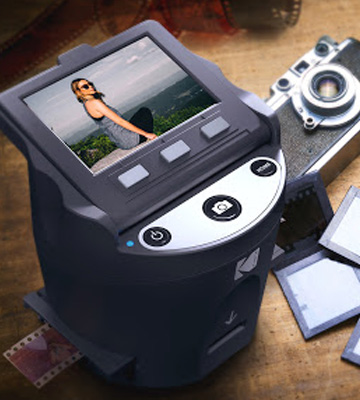
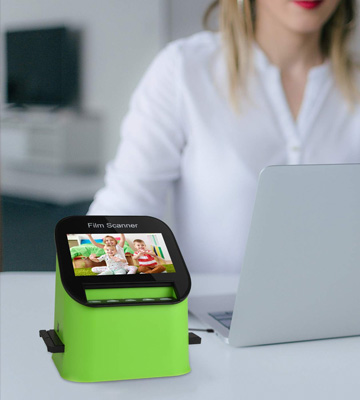

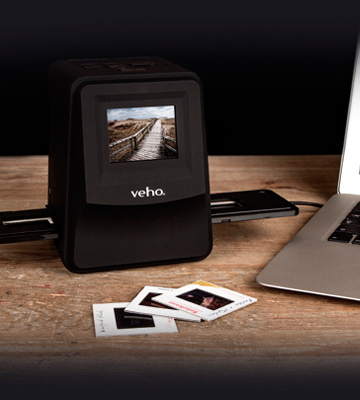
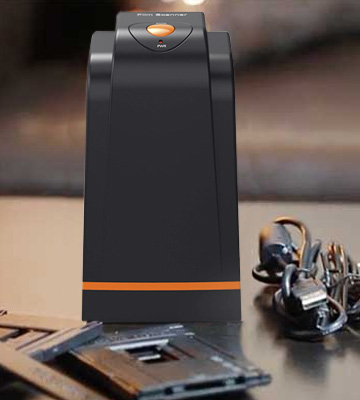

Your comment was successfully sent
Error! Please try again later